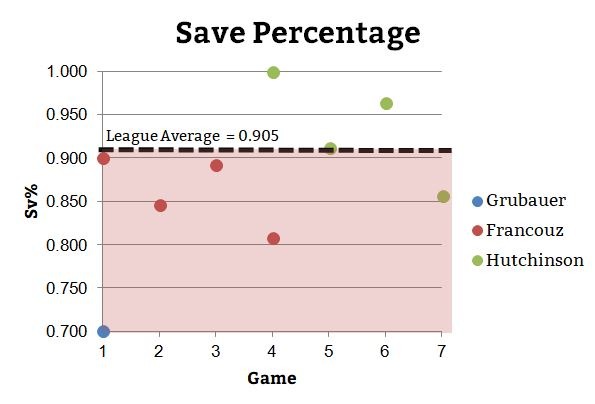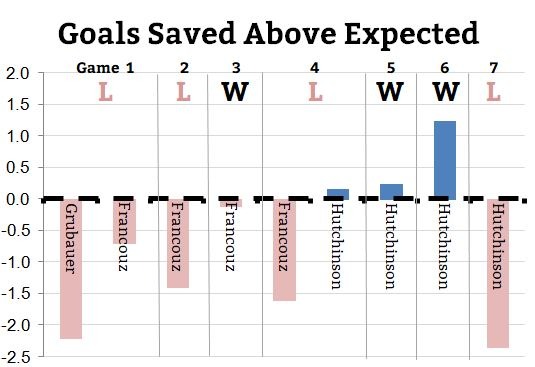© 2025 ALLCITY Network Inc.
All rights reserved.

As many of you are (painfully) aware, the Avs lost 5-4 to the Dallas Stars in Game 7 of the NHL’s second round Friday afternoon. After coming in as a heavy favorite, the team not only failed to end the series quickly but came up short in the end.
How did a roster with so much promise, one that finished the regular season with 10 more points than their opponent, one that was pegged as a true Stanley Cup contender find themselves boarding a plane back to Denver before even half the job was done?
What happened?
And perhaps more importantly, where do they go from here?
Injuries
Look, all teams have to play through key injuries. It’s the playoffs; it’s expected. Dallas played most of this series without their starting goalie (Bishop) and a serviceable third-pairing defenseman (Johns). There is a certain level of “next man up” that any team looking to go on a deep run must have, and injuries shouldn’t be an excuse for a series loss.
But there also reaches a point when your next man up starts to need a next man up that you veer out of normal playoffs baseline and into “oh come on” territory. And that? That would be where the Avs spent most of this series.
Game 1. No Matt Calvert at puck drop, so the Avs start the round without one of their top penalty killers and an important depth scoring piece.
Then starting goalie Philipp Grubauer goes down.
Then veteran defenseman, alternate captain, and top penalty killer Erik Johnson follows.
Then Joonas Donskoi, who finished 8th in scoring during the regular season, is out after Game 2.
Then backup Pavel Francouz – already in for the injured Grubauer – is pulled out after some uncharacteristically bad starts that makes one wonder if he was playing injured. He didn’t return this series and was instead replaced by Michael Hutchinson, who posted an awful .886 save percentage with the Maple Leafs this year before spending most of the season in the minors.
The player who replaced Johnson? Conor Timmins. He leaves Game 6 with an injury.
Later that same game? The captain and top-line forward Gabe Landeskog gets a skate to the knee and wouldn’t play in Game 7.
So all tallied up, the Avs played their most important game of the season without one of their top-line players, two of their critical penalty killers, two reliable depth forwards (including the guy who knocked them out of Game 7 last year as a Shark in Donskoi), one of the players they brought in due to injury, and both of their normal netminders. And this is on top of Colin Wilson, a noted playoff performer who didn’t suit up this postseason.
On top of that, defenseman Kevin Connauton and forward Sheldon Dries only received 6 minutes of ice time in Game 7, so the Avs were essentially playing 5 defensemen and 11 forwards. Of those 11 attackers, a further two (Logan O’Connor and Tyson Jost) started the postseason as scratches.
In a hard cap league, no club has the depth to gracefully withstand losing a quarter of its roster, particularly when that includes 100% of its normal goaltenders. By the end, this was not the favored team many saw going into the series – it was a shell of one with a frightening number of AHL patch jobs sprinkled throughout.
While there were certainly other issues with this series, nearly all of them were amplified because the Avs were forced to play with one hand tied behind their back. That’s not using injuries as an excuse – that’s understanding the reality that the Avs received some unusually awful luck in this department and it’s the number one reason they’re going home.
So how do they fix that? Perhaps there is some more preventative therapy that the training staff can implement. Maybe there is some concern that Philipp Grubauer – who has never played more than 49 games in both a regular and postseason combined – has some durability issues.
But frankly, there is nothing concrete that can be fixed when it comes to injuries. They’re luck of the draw. And no, the Avs don’t need to get bigger in some hope of getting sturdier. Even Landeskog who plays that style of game found himself sitting for Game 7.
Injuries plagued the Avs all season and there’s no rhyme or reason as to why. There’s no one to blame, there’s nothing that can be actively fixed. Is that an unsatisfying answer when emotions are high after a lost series? Oh, absolutely. But all the Avs can do is keep tending to their depth as best as possible and hope for better luck next year.
Goaltending
As mentioned above, this section deserves a major asterisk that with even a slight bit of health, we’re likely talking about a matchup with Vegas instead of going into these gory details. However, what happened happened, and it’s worth discussing because goaltending was the biggest on-ice failure point of the series.
Grubauer only played 17 minutes this round before his season ended. During that time, the Avs gave up 0.79 expected goals over the course of 10 shots. Somehow not one, not two, but three ended up behind him before he apparently pulled something in his leg and left in pain.
Overall in the playoffs, Grubauer was fine. In his 7 appearances, he faced 10.7 expected goals and allowed 12. If you take out the debacle that was Game 1 of the Stars series, he faced 9.91 xG and allowed 9. The round robin game against Vegas was his only other start where he posted less than a league-average .905 save percentage, and he finished playoffs with a .922 overall.
Would he have rebounded if healthy? It’s likely. He held a .916 save percentage over 36 games in the regular season, so he was more often than not above average. But injuries happen, he didn’t rebound, and the torch was passed to Francouz.
Pavel Francouz finished the regular season with a strong .923 save percentage over the course of 34 games. There was some talk of him pushing for the starting job as the playoffs began, and the Avs tandem was seen as one of the stronger ones in the postseason.
Even though coach Jared Bednar decided to start Grubauer instead, the one appearance Francouz made during the round robin was a rousing success as he shut out the Stars. His one appearance against the Coyotes wasn’t quite as good, but he still provided baseline .905 tending and was right in line with the 2 xG he faced.
Then he entered Game 1 vs the Stars in relief and it all went downhill from there.
In Game 1, he faced 20 shots, 1.3 xG, and let in 2 for a .900 save percentage. Game 2 was worse, facing 26 shots, 2.6 xG, and allowing 4 for .846 save percentage. Game 3 was closer to respectability, facing 37 shots, 3.89 xG, allowing 4 for a .892 save percentage and helping the Avs hold on for a win. Then Game 4 hit, and he saw 26 shots, allowed 5 on 3.4 xG and posted a measly .808 before getting pulled and his season ending.
In the series overall, Francouz saw 109 shots and allowed 15. That comes out to an awful .862 save percentage. And the team in front of him wasn’t exactly to blame – he only faced 11.3 expected goals, so the defense did a decent job keeping his workload down.
Simply put, he wasn’t good enough. 3 of the 4 Avs losses came with him in net posting well below average numbers. It’s possible he was playing injured – we’ll never know for sure. But injured or not, it’s a struggle to win when your goalie doesn’t do his job. And “Frankie”, as he’s known in the locker room, didn’t get it done.
After he left, Michael Hutchinson came in. Games 5 and 6 were the only times all series the Avs received league average goaltending, and they won both games comfortably. Hutchinson often looked shaky, but he provided a .912 and .964 save percentage respectively. As a bonus, he even saved a goal above expected in Game 6.
Then he, unfortunately, returned to the goalie he was all year in Game 7 and that was that. A save percentage of .856 and allowing 2.4 goals more than expected is going to make closing out any series somewhat difficult.
In the end, the Avs proved that they don’t need elite goaltending to win in the playoffs. League average, or even a little below, is good enough. Unfortunately, in the four games they lost, they were sabotaged in net by very leaky teammates.
Simply put, the goaltending failed in this series.
So where do the Avs go from here? Well, they have some decisions to make this offseason. Grubauer and Francouz are both under contract for next season, but Grubauer has some durability question marks and Francouz’s one playoff run ended disastrously.
Was this just the product of bad luck and small samples, or is it an area the Avs actively need to upgrade? Without a crystal ball, it’s really hard to say, but it’s a call Sakic will have to make.
Special Teams
The Avs’ power play was 4 for 32 this series, clocking in at 12.5%. The regular season average? 19% for the team, 20% for the league. That’s a missing 2-3 goals.
Their penalty kill? 9 goals allowed in 23 attempts, or a sad 60.9%. The team maintained a 81.4% PK during the season, slightly above league average of 80%. If they had carried that number to this series, Dallas would have 4-5 fewer tallies on the man advantage.
When you take three penalties in Game 7 and have all of them end up in the back of your net, that’s unacceptable regardless of opponent.
When you only score four power plays in a series where you’re facing a backup for the majority of it? Also unacceptable.
The Avs are a 5v5 team and have been all year. We knew that they were unlikely to win this series on special teams. However, their absolutely horrific and inexcusable performances and complete inability to counter Dallas in either area is a major reason why they’re headed home early.
Power Play
The Avs are in general a low-quality team offensively. At even strength this season, they ranked 16th in expected goals – an added up measure of how likely shots are to become a goal – per 60 and 23rd in high danger shot attempts per 60 from the goalie’s doorstep.
However, they do the vast majority of their damage at the medium danger range, leading the league in both goals (61) and shooting percentage (12.1%) from those areas. The Avs also shoot the puck a lot 5v5, finishing 7th in shot attempts per game.
In short, they bring snipes and quantity over quality.
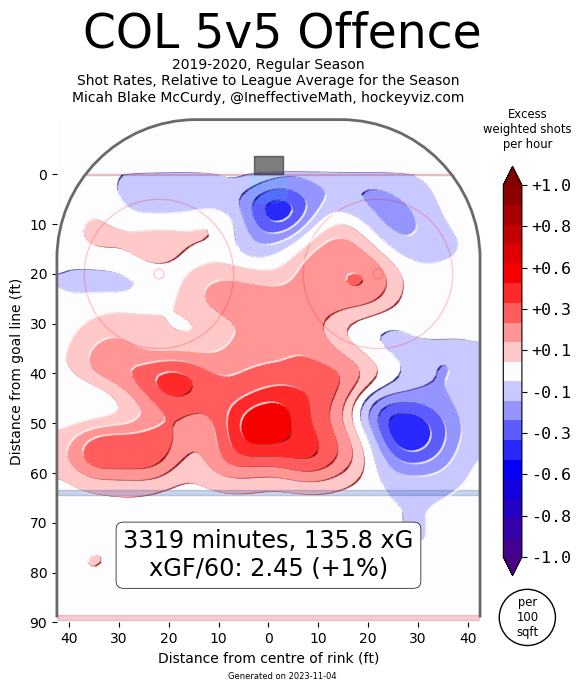
When you look at the power play this season, a couple trends stick out. First off, they still don’t generate high danger chances, ranking 22nd in xG and 21st in high danger attempts. But their medium danger shots? Those drop to 13th in the league while their shooting percentage remains largely steady. Their low danger shot attempts are even worse, clocking in at 19th. The club also drops to 18th in shot attempts overall.
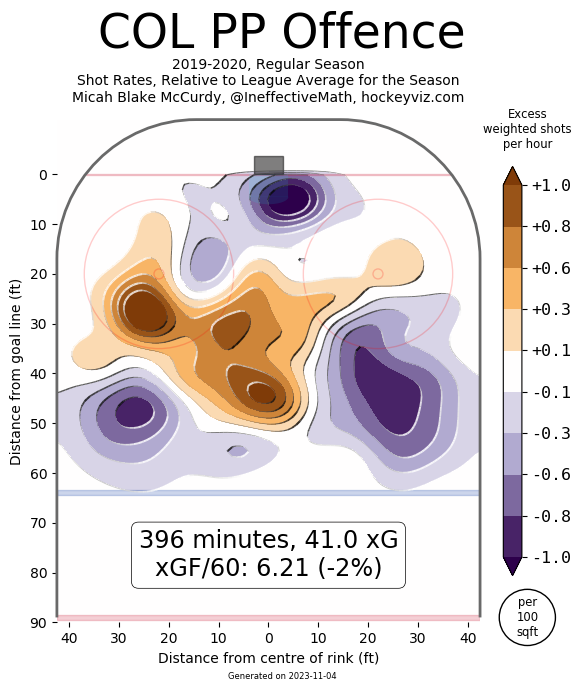
So what’s the reason for the drop? On 5v5, their cycle depends on movement away from the puck and quick decisions that throw the defense and goalie off balance. They use their speed and moving feet to get to the puck to keep it in the zone, make reads to find open areas and find each other, and utilize smart plays to win 50/50 battles along the boards.
They also don’t look for the perfect play and shoot from most everywhere in a quantity over quality approach. It works well and ended up tying them for the league lead in 5v5 goals this season at 162.
On the power play, the club is very content to stand in certain spots. Instead of making fluid reads, they will catch a pass, juggle it for a few seconds, then pass it back to the point.
Their feet are often not moving and allow the puck to exit the zone, and the lack of creativity and chaos makes it easy for opposing teams to collapse to the middle, take away the shots from the wings, the lane through the middle of the ice, and the majority of the Avs scoring options.
The Avs man advantage turns into a low danger passing clinic that eats time on the clock and little else.
The book on the power play is easy to spot from a mile away, and the Avs struggled to counter Dallas’s penalty kill. Not that they made Dallas work particularly hard – their contentment to pass at the perimeter for the vast majority of the series played directly into their opposition’s hands. It was only the power plays where they started to move their feet that they generated scoring chances.
The Avs over the course of the series did generate 7.18 xG shorthanded, 5.75 of which came 5v4. There certainly was an element of bad shooting luck that played into it. They also did adjust and move away from the very predictable drop pass to MacKinnon zone entry, but many of the same systemic problems kept cropping up once they made it in there.
This power play system may work for some teams, but it does a very poor job of maximizing the Avs’ greatest strength – their speed. While Rantanen and MacKinnon are excellent snipers, the over-reliance on their shooting abilities from the half boards has made the man advantage stale and easy to counter.
The Avs top power play unit was intact injury-wise until the last game of the series, and they still only managed 4 goals in 32 attempts.
Shooting luck or not, that’s not good enough.
The power play is broken. It’s a systems issue, not a talent one. The coaching staff has consistently failed to turn it into the deadly weapon it should be, and they lost a series against a team that took a lot of penalties without making them pay.
What incentive is there not to take a run at the Avs when you know their man advantage is this easy to shut down?
Assistant coach Ray Bennett is mostly in charge of the power play, but Bednar is the head coach. The buck stops with him. If the Avs would like to avoid a repeat of the mistakes of this series, this is an area that can and should be addressed this offseason.
I’m not calling for anyone to lose their job, but they need new ideas and need to take whatever path is necessary to make that happen. This was not just a small sample – it’s an indictment of their entire approach that was picked apart and laid bare for the world to see.
Penalty Kill
As bad as the power play was, the penalty kill was arguably worse. Unfortunately, your goalie is your most important penalty killer and that didn’t exactly go swimmingly for the Avs this series. Unlike the power play, the PK also suffered other major injury losses early in Calvert and Johnson. There are at least some extenuating factors in this area that should clear themselves up before next season.
Too bad the Avs penalty kill wasn’t great to begin with.
At 5v5 during the regular season, the Avs were a pretty solid team defensively. They ranked 14th in shots allowed, but their expected goals against was up at 10th. A big part of the improvement was how few chances they allowed from the crease area, finishing 6th best in the league at minimizing those shots.
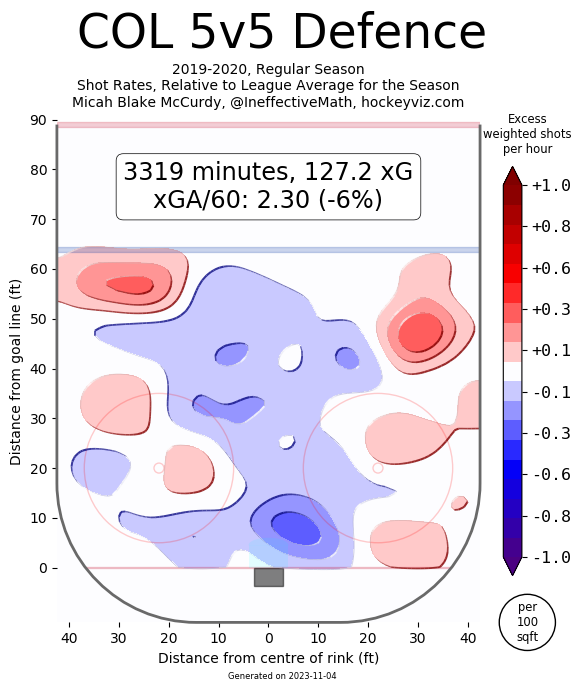
Now compare that to their penalty kill and see if you can spot the difference, keeping in mind brown = bad.
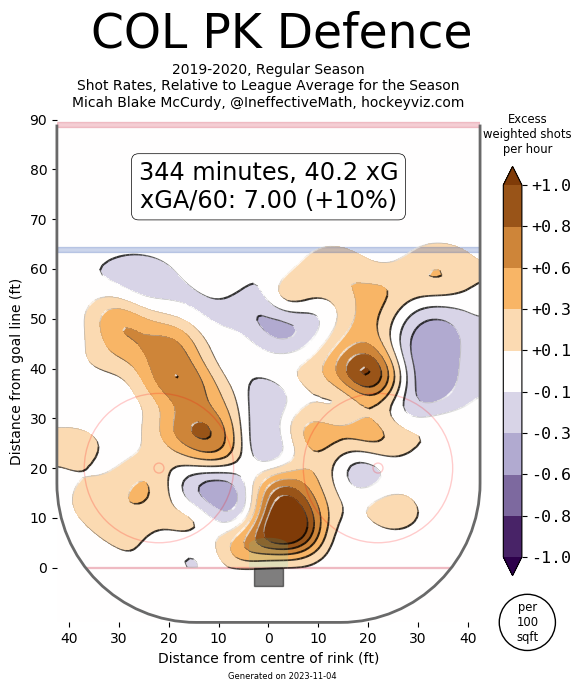
The Avs penalty kill finished the regular season 24th in high danger chances against, 20th in expected goals against, and 25th in overall shot attempts allowed. The only thing that kept them above average on the kill? Their .874 goaltending, good for 9th in the league.
Funny what happens when you rely on goaltending and it decides to not show up.
In this series, the Avs were shorthanded 23 times and received .830 goaltending. They allowed 6.78 expected goals and had 8 scored on them at 5v4. There was another added in Game 2 on a 5v3 and one in Game 7 on a delayed penalty.
For those keeping track at home, that means a total of 10 of Dallas’s 28 goals (36%) came off Avs penalties.
To be fair, Francouz actually wasn’t too bad on the penalty kill. He saw 5.09 expected goals against – which is not good from the skaters in front of him in only 19 minutes of shorthanded time – and he allowed in 5. Hutchinson though saw 2.37 xG in 13 minutes and allowed in 4.
If they had managed even a league average kill with their defense or Hutchinson’s save percentage, half of those tallies wouldn’t exist. That means this article probably wouldn’t exist either.
But it does and here we are. So how can the Avs look to improve?
Just like on the power play, the Avs have failed to understand that their speed is what they need to maximize. Are their regulars of Erik Johnson, Ryan Graves, Ian Cole, Nikita Zadorov, Matt Nieto, JT Compher, Matt Calvert, and PE Bellemare known as burners? Not exactly.
But we’ve seen from their play at 5v5 that an aggressive, moving feet, intuitive approach fits this team. Obviously being down a man drastically changes the defensive dynamic and a mindset based more on challenging players opens the team up for scrambly collapses.
With that said, what they’re doing right now isn’t working either. It’s too passive, it gets beat, and it allows a lot of high danger chances. It also might be worth looking at changing personnel and potentially subbing in Tyson Jost, Martin Kaut, or Sam Girard to boost the talent available.
Nolan Pratt is the assistant in charge of the kill. He’s technically been with the Avs longer than Bednar and was hired in the twilight of Patrick Roy‘s coaching tenure.
Under his watch, these issues have plagued the system for years but the goaltending has largely covered them up. While that still gets the job done, this series exposed just how quickly that can go south with no back up plan if your netminder is having a bad night.
Just like the power play, if the Avs are looking to get better this offseason, this would be a great place to start.
Mentality
To the eye test, it felt like the Avs started this series disconcertingly slow, showed up when elimination was on the line, then fell apart when it mattered in Game 7. To the eye test, it could raise serious questions about the mentality of this team moving forward and if they need to ship certain players out to get those who can show up to big moments and win.
It’s important to remember that sometimes eyes can lie. In this series, the Avs outscored Dallas 29 to 28. At 5v5, they had the puck 53% of the time, they outshot, they outchanced, they outscored. The noted allergic to the crease team had 70 high danger chances to the Stars’ 55, but both teams ended up with 10 even-strength goals from that area. At all strengths- even including the awful special teams – the Avs limited Dallas to 21 expected goals while generating 25 of their own.
Other than Game 6 where score effects took over and Dallas spent the whole game trailing, the series was pretty close chance-wise at 5v5. Game 3 tilted heavily Dallas as far as dangerous chances (they lost), then Game 4 saw the same thing happen in reverse (the Avs lost). Game 7 was tilted pretty heavily to the Avs at evens, but it wasn’t quite enough to overcome letting in 3 shorthanded goals.
In the end, Games 1, 4, and 7 were lost due to goaltending. In Game 2, they gave up two quick goals on the penalty kill, MacKinnon hit a post on a power play, and a very very lucky goal bounced off of Alexander Radulov’s shoulder. After that, the Avs received three power plays and couldn’t convert on any of them, so that game slots pretty cleanly into the special teams loss category.
To some extent, coming in the favorite in this series may have played some role. Other than an Arizona team that didn’t pose much of a threat, this is the first time in nearly two decades the Avs have legitimately been the favorite in a series, both as far as the standings and the stats are concerned.
The skaters didn’t have a great showing in Game 1, but they responded well in Game 2 until special teams got in their way. They played well the rest of the series, but when it feels like everything is ending up in the back of your net, it’s pretty tough to get a rhythm going.
Credit to the Stars – they came out with a gameplan and executed it well. Were they the better team? Probably not. But the Avs shot themselves in the foot and left the door wide open for the Stars to waltz through. They got the job done; the Avs didn’t.
Play this series again – especially with a similar list of injured players for both sides – and Vegas would be playing a different squad next week. But the Avs couldn’t catch a break and Dallas caught just enough. It’s unfortunate, but sometimes sports aren’t fair.
Without a doubt, this series was a gut punch way to end a season (thanks 2020). But it also drives home that the Avs are absolutely a Cup-worthy roster. Sure, there’s a few areas that could be upgraded, but especially at even strength, this is a very good hockey team. Their goaltending and special teams – frustrating as they can be – were way below their season averages. There’s good reason to assume they’ll rebound at least to that level even if nothing is changed.
More than anything, this team caught some hard breaks in some key areas at some bad times. No team is perfect, and you need to be both good AND lucky to kiss the Stanley Cup.
Lady Luck decided this wasn’t our year.
Decisions will need to be made this fall about goaltending and the coaching staff. While there’s a lot of “shit happens” that can be blamed for this series, those are the two areas where the Avs front office can choose to explore alternatives. Do they stick with the same crew and hope that what ailed them clears up? Or do they take a chance and move on looking for something new?
Regardless, with a handful of young players pushing for the roster next year, the future is even brighter for this franchise. Colorado is in good hands with GM Joe Sakic, and this is the first of many runs to come.
Does it suck this one ended early? Sure does. But take heart Avalanche fans – this season may be over, but this team ain’t done yet.
Comments
Share your thoughts
Join the conversation



